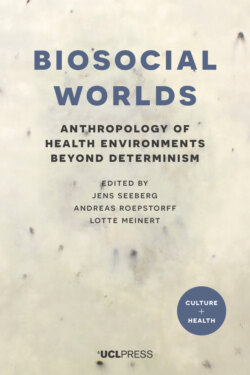Читать книгу Biosocial Worlds - Группа авторов - Страница 27
На сайте Литреса книга снята с продажи.
Toxic living
ОглавлениеFor a decade or more, researchers have been working to elucidate the effects on neurodevelopment of exposure to neurotoxins in utero and during early life. Recent work has highlighted epigenetic effects and an apparent intergenerational aftermath of such exposures. A 2006 review of an array of 201 neurotoxins, ranging from arsenic to benzene and PCBs, concluded that exposure to hundreds of industrial chemicals is potentially damaging to the developing brains of children worldwide, although it is noted that both timing and the amount of exposure are significant (Grandjean and Landrigan 2006). Evidence links environmental pollutants to epigenetic marks associated with a range of disease endpoints, although it is emphasised that many of these changes have been shown to be reversible and hence preventive measures are feasible (Senut et al. 2012). Lead is the most closely researched toxin to date; it has been shown repeatedly that there is no safe level of exposure during the early years of development and that it causes many epigenetic effects. Decreased brain volume is recognised as lead-related brain atrophy, and is most pronounced in males (Cecil et al. 2008). Research has also shown negative effects of lead exposure on language function (Yuan et al. 2009).
Markowitz and Rosner graphically describe the ongoing lead paint scandal in the US that has steadily unfolded for more than a half-century (Markowitz and Rosner 2013). Over the years, millions of children have been exposed in their homes to potential lead poisoning, although reliable numbers are not available. It is estimated that today over 500,000 children between 1 and 5 years old have lead levels above that which policymakers currently regard as a safe level. Reminiscent of the infamous Tuskegee experiments conducted on African-Americans, 100 children, mostly African-American, some less than a year old, living in poor family dwellings where lead paint had been used, have been systematically studied for the effects of lead exposure on their development. A judge who presided over a lawsuit described these young research subjects as ‘canaries in the coalmine’ (Fowler 2013).
It has been shown that lead released from a woman’s bones during pregnancy can increase risk for preterm deliveries and low birth weight and, further, affect gene expression in infants involving changes to DNA methylation that may well have lifelong effects. One researcher is quoted as stating: ‘lead exposure, rather than a poor social environment, is a key contributor to […] subsequent cognitive and behaviour problems’ (Radiological Society of North America 2009). Such a claim prioritises one variable over another, causing a distortion. It is highly likely that lead exposure does irreparable harm to all humans, but those individuals who are at the greatest risk of being exposed are almost exclusively economically deprived. In 2014, in the impoverished town of Flint, Michigan, with a population of 100,000, nearly 60 per cent of whom are African-American, a water crisis exploded. It became clear that between 6,000 and 12,000 children had been extensively exposed to lead contamination when, in order to save money, the Flint water source was changed from a safe source, to one involving use of ageing pipes linked to the Flint river that leached lead into the water supply. As one commentator stated, ‘some of the darkest chapters in American industrialisation are written in lead’ (El Akkad 2016) and we learnt recently that ‘Dozens of California communities have seen recent rates of childhood lead poisoning that exceeds those of Flint, Michigan’ (Schneyer and Pell 2017).
Thanks to the intrepid battle fought by Rachel Carson, dichlorodiphenyltrichloroethane (DDT) was banned in the early 1970s, first in the US and then worldwide, although it continues to be used in certain malarial regions. Furthermore, the use of polychlorinated biphenyls (PCBs) is banned or severely restricted in most countries today, but about 10 per cent of the PCBs produced since the late 1920s remain in the environment today. They are released into the environment primarily from incinerators and build up in the fatty tissues of animals living in water or on land and are passed along the food chain to humans. Dioxins are found throughout the world and accumulate in the food chain, mainly in the fatty tissue of animals. They are highly toxic and cause reproductive and developmental problems, damage the immune system, interfere with hormones and cause cancer. Dioxin enters the environment primarily from incinerators; of the 419 types of dioxin-related compounds, 30 have significant toxicity (WHO 2016, 2).
The effects of PCBs, dioxin and other toxins in the Arctic are more devastating than elsewhere. Legislation against these chemicals is not effective in the extreme north as yet because toxic residues slowly drift toward the Arctic and accumulate there, making it one of the most contaminated places on earth. The body fat of seals, whales and walruses hunted for food is highly contaminated, as is the breast milk of many Inuit women. An Inuit grandmother, politically active in circumpolar meetings, is quoted as stating: ‘When women have to think twice about breast feeding their babies, surely that must be a wake-up call to the world’ (Johansen 2003, 479). The situation is exacerbated because the cost of store-bought food is beyond the reach of many Arctic residents.
